 |
 |
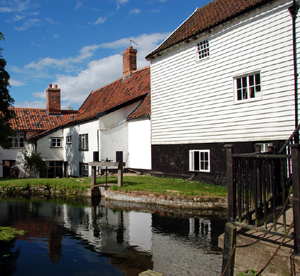
|
Only a few watermills survived into the 20th century. However, we must not think that the mills which survived were very much like their predecessors in medieval times. The first watermills used wood exclusively, while the Victorians were routinely producing cast iron water wheels and steel gears. Steam power had been added to augment water power in some places, while others were to include diesel engines and steel rollers to replace millstones, if they warranted the investment, or had sufficient faith in the future.
Water mills also tended to be handed down within a family, so the miller might change over the years, but the name stayed the same.
Facts or suppositions about each mill will be included below, and the reader should be aware that in a time span of up to a thousand years, mill structures and methods will have changed, and even the site of the individual mill may have shifted somewhat.
It should also be noted that a miller might be responsible for both a watermill and a windmill, which may well be located fairly close by the watermill.
|
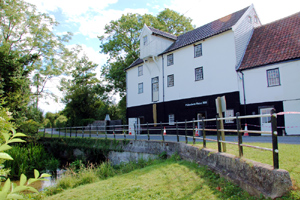 |
Pakenham Mill In the Domesday Book, the vill of Pakenham was said to possess two water mills before 1066, but by 1086 there was only one in operation. By 1280 the village also had two windmills. On the site of the present watermill, evidence has been found of a Tudor period mill, which was replaced by the present building in the late 18th century. The Tudor mill was smaller and only two thirds of the new building was rebuilt on the old foundations. The southern third covered new ground. This mill was in continuous operation until it closed in 1974. In April 1978 the Suffolk Preservation Society bought the mill with the aid of a large anonymous donation. The watermill is now largely renovated and in running order. Demonstrations are in operation on selected weekends, and flour and other products milled there are available for sale. Fuller information of the mill in its restored state is available on its own webpage accessible from our watermills homepage. |
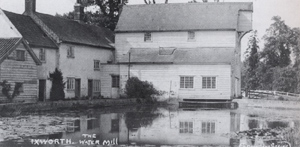 |
Ixworth Mill This mill stands on the River Blackbourne, and is downstream from Pakenham Mill. The waterwheel drove four pairs of stones. It was built in 1800, and survived as a working mill until 1948. This picture is by Farringdon Postcards and is dated August 1912. |
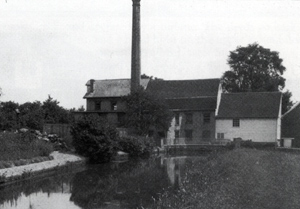 |
Clare Water Mill Clare mill stood on the River Stour. It had four pairs of stones driven by a waterwheel and four pairs driven by a steam engine. It also had a roller plant, using steel rollers in place of millstones. The steam engine was 12 hp and the chimney shown here stood 72 feet tall. |
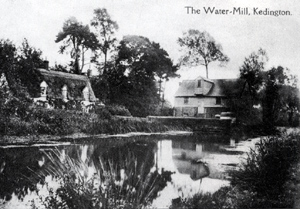 |
Kedington Water Mill
Kedington mill stood on the River Stour. It closed down in 1901. It had an undershot waterwheel, but it was unusual because the wheel was extremely wide, at 8ft 8in. The wheel was 8 feet in diameter.
Domesday Book recorded this mill as existing prior to 1066, but St Edmunds only held half of it. Another lord must have held the other half.
|
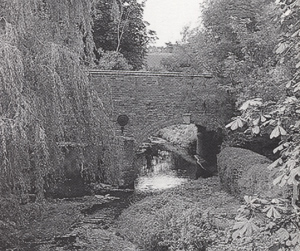 |
Long Melford Water Mills Domesday Book recorded two mills at Melford, apparently dating back prior to 1066. The name "Melford" probably derives from the description of the ford which had to be crossed at the foot of Melford Green. As part of the turnpiking of the road, the ford at Long Melford was finally bridged in 1762. The town's name indicates that a watermill was located very near to this spot. The "ford at the mill" was a ford no longer, after 1762. The bridge, which is shown here, crossed the Chad Brook, a tributary of the River Stour. This view is from the footpath near the mill.
Domesday Book recorded a mill at Ingham dating back prior to 1066. It was located in Bradmere hundred. Later Bradmere and Blackbourn would be united as the Blackbourn double hundred, presumably because some of the manorial holdings were inconveniently divided across the two areas. Culford had no mill and was possibly served by this mill.
One of Abbot Samson's leases dated to 1186 to 1200, recorded that two watermills at Ingham were leased for life to Solomon of Whepstead.
By the time of the Hundred Rolls in 1280, Ingham had two watermills and one windmill.
Domesday Book recorded a mill at Stowlangtoft dating back prior to 1066. However, by 1279/80, it had been replaced by a windmill.
|
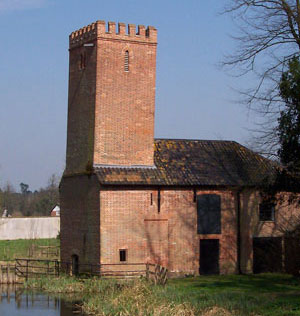 |
Euston Water Mill In the Domesday Book, "in Euston Adelund holds from the abbot (of Bury St Edmunds) 2 free men with 1 carucate of land. 4 villans. Then as now 2 ploughs in demesne and half a plough belonging to the men. 3 acres of meadow. 2 mills." So in 1086 the manor of Euston possessed two watermills, presumably along the River Blackbourne.
The picture and the following details of this watermill are taken from the website of the Suffolk Mill Group at : The group describe it as "Crosswater Mill , on the River Ouse, trib. River Blackbourne". Wikipedia's entry on the Euston Estate includes the following information: "Euston's watermill was built in the 1670s by Sir Samuel Morland for irrigation and grinding corn. In 1731, it was redesigned by William Kent to resemble a church, and in 1859 an iron waterwheel was added by Charles Burrell." Charles Burrell was an engineer at Thetford who became best known for the production of traction engines. The mill and its Burrell axle still stands in 2011. |
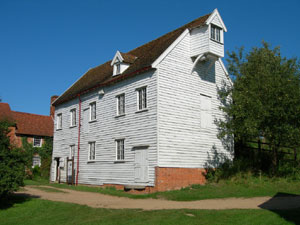 |
Alton Watermill, Mill House and Cart Lodge Although this mill is strictly from outside our West Suffolk focus of interest, it does give visitors to Stowmarket's Museum of Rural Life an opportunity to see demonstrations of a watermill in action on some occasions each year. This mill was originally located between Holbrook and Stutton, in the Shotley peninsula, and the site is now covered by Alton Water reservoir. The mill house dates from 1765 although an extension was added in the Victorian period. The mill and the cart lodge were both built at the turn of the 19th century. They were relocated to the museum in 1973 prior to the construction of Alton water reservoir under whose waters they would otherwise now rest. The buildings stand in the same layout as they were in the village of Holbrook. In 1879 Robert Southgate (1850-1922) became the miller. Before serving his millers apprenticeship at Bradley Mill, he attended grammar school. This made him well educated in comparison to many other workers. His daughter recalls him reading the weekly papers to fellow villagers. A millerís job was extremely hard work and time consuming. Robert Southgate worked day and night, closing at 6pm on Saturday and re-opening at 6am on Monday. Southgate was also a corn-merchant with a stand on the corn exchange in Ipswich, and not only did he produce large sacks of flour to sell to businesses, but he also ground smaller amounts of wheat brought to him by the locals. |
|
A History of the Abbey of Bury St Edmunds, 1182-1256 by Antonia Gransden, 2007 Information first prepared by David Addy, 15th July 2008
|
| Go to Watermills Homepage |
Page created 15th July 2008 Last Updated on 7th May 2011 | Go to Main Home Page |